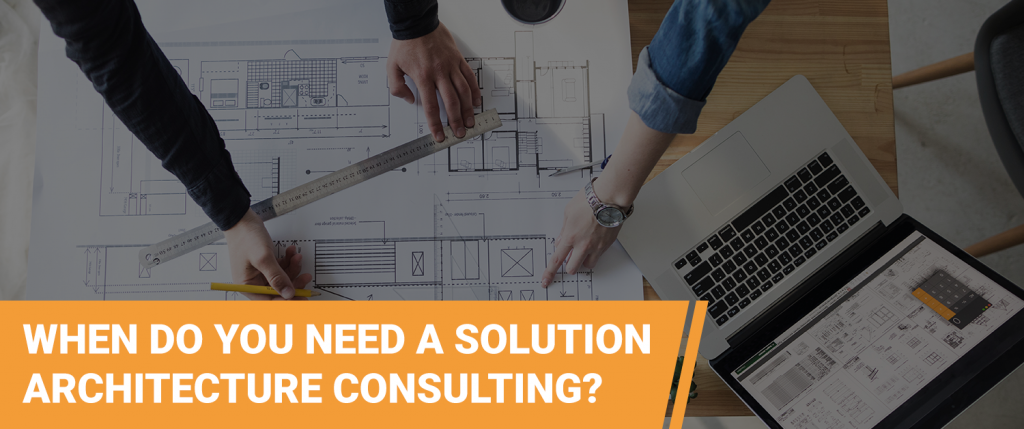
Has your time calculation for the software development gone overboard? Has your cost to deliver gone beyond your expectations? Do you want to improve the efficiency of your project release?
A leading consultancy firm- McKinsey, expresses the same concerns in its recent document, which says that – “On an average, large software projects run 66% over budget and 33% over time, while delivering 17% less value than predicted. Most of the time, companies can recover from a failure, but a full 17% of projects fail to the point of threatening the company’s survival.”
These concerns can well be answered and mitigated with the help of an intelligent document called “Solution Architecture.”
Solution architecture is a time-driven document that analyzes the requirements of a project. It lists out the stages of development and predicts the estimated man-hours required to achieve a certain goal at each level in the development.
A Solution Architecture document starts off by emphasizing on business context. Then it shifts its focus to data. It defines the flow of data as per the intent and the expectation of the end-user. It also takes into account all the functional and non-functional variables of business processes and their interactive overlaps. A solution architecture document envisions an enterprise solution, along with its associated applications and all of its integrated processes, that can address specific business needs and requirements.
It is not a static document; instead, it incorporates dynamism in all current and future solutions, applications, and processes of the project from the incubation stage to the deployment stage. It addresses all the stakeholders, technology team, marketing team, finance team, human resource team, end-users, customers, state and overall technology environment, and industry.
Solution architecture (SA) is a complex process with many sub-processes that bridges the gap between business problems and technology solutions. It includes:
- Finding the best tech solution among all the possible ones to solve existing business problems.
- Describing the structure, characteristics, behavior, and other aspects of the software to all the project stakeholders.
- Defining features, phases, and solution requirements.
- Explaining the type of data that is needed and the kind that will be generated with the help of the product being developed.
- Providing specifications according to which the solution is defined, managed and delivered.
- Identifying the resources needed to meet the requirements.
- Mentioning the non-functional requirements like reliability, speed, throughput, availability, security, and scalability.
How exactly can a solution architecture help you in your next big project?
1. Matching solutions with the existing corporate environment
Usually, companies have their existing business processes, operating systems, information context, and integration requirements. The role of a solution architecture is to ensure that the new system fits into the existing enterprise environment. A solution architect needs to understand how all the parts of a business model work together, including processes, operating systems, and application architectures. Understanding these processes will allow him to design a specific solution that fits perfectly in the current business environment.
2. Meeting the requirements of all stakeholders

A product generally has many stakeholders that can be both technical as well as non-technical. Thus, meeting all stakeholders’ requirements is one of the most challenging parts of software product development. A solution architect’s key role is to translate technical project details into a language that both management and non-technical stakeholders can understand. A solution architect ensures that all the stakeholders are regularly informed about software development progress, costs, and budgeting.
3. Identifying the key aspects of the project
Each project has certain key aspects that need to be identified during this phase. These aspects include:
- Most suitable technology
- Risks involved
- Project Scope
- Project Cost
- Project Quality
- Time of development
- Resources required
The solution architect must understand all these key aspects, compare them, and propose the most feasible technical solution to meet the project goals.
4. Selecting the right technology stack
Before getting started with the project development, one needs to choose the right tech stack for the project development, which is not an easy task, especially for a business owner with a non-technical background. There are many options in the market and choosing the wrong language or framework might have serious consequences. The solution architect’s role here is to assess the available technologies, compare them with each other, and find the most suitable tech stack for a particular project.
5. Compliance with non-functional requirements
Non-functional requirements denote the quality attributes of a project. Other than functional requirements, each software project has to meet several non-functional requirements as well. A few of the standard non-functional requirements of any project include security, performance, maintainability, scalability, usability, and reliability. The solution architect’s role is to analyze all the non-functional requirements of a project and to ensure that the final outcome meets them.
When do you need a solution to architecture consulting?

Now that we know what solution architecture means and what it does, the next big question is: Do you need a solution architect for every single project?
The answer is a big NO. If you are implementing simple tech modules that are already proven to be working in similar contexts, you need not have a solution architect. However, if your business has a complex enterprise architecture that involves multiple interlinked software products in a functioning ecosystem, or you need to completely rebuild your legacy software, or you want to make a set of strategic technological decisions, the relevance of a well-drafted solution architecture becomes obvious.
Let’s have a look at the cases when solution architecture consulting is highly recommended:
1. You need to enhance your enterprise ecosystem and do not know which solution will fit the best
Companies with existing enterprise ecosystems cannot afford downtime and need to ensure non-disruptive performance. A solution architect’s role is to analyze your existing enterprise ecosystem, evaluate multiple options, and suggest the most relevant one meet your business needs in terms of technology, human, and financial resources.
2. You are using legacy software products and planning to replace them completely
The solution architect will analyze your system along with your existing and future business needs and will decide whether it makes sense to rebuild your enterprise apps from scratch or introduce out-of-the-box solutions from other existing assets. Furthermore, the SA will also supervise the implementation process.
3. You need a digital transformation of your business
Suppose your business is undergoing a full-scale digital transformation involving a complete hardware and software refresh. In that case, you will be required to do an in-depth analysis of the existing business model and evaluate how you deliver value to your customers and what you will eventually deliver after digital transformation. A solution architecture can answer all these questions by linking technology with business perspectives.
4. Your project has lots of risks involved
Solution architecture is necessary for the projects where many technology risks are present, requirements are ever-changing and uncertain, multiple products must be implemented at once, or the underlying technologies aren’t approved yet. In such a situation, a well-drafted solution architecture can help you evaluate the risks involved and ways to mitigate it.
5. You need to pitch a product road-map to investors
Suppose you want to present a future product to investors and stakeholders. In that case, a solution architect can help you explain your project idea to the investors, suggest the technologies that will match product requirements, and communicate the reasoning in plain and clear business terms.
6. You need to set up communications between stakeholders and engineers
A solution architect will help to fill the communication gap between technical and non-technical stakeholders of the project with the development team. It also ensures that all the project teams are well-synced with the project’s core purpose. By collaborating with the project management team, solution architects cover the risks of product misalignment with stakeholder requirements and ensure to produce a quality technical project outcome that fits the defined purpose.
A lot of people underestimate the importance of solution architecture. Some people believe that it will increase the project cost and their profits might go down, but it’s a big mistake! When you plan to build your dream house, you hire a good architect to ensure that you will get a house with a solid foundation and as per your requirements. It’s the same with solution architecture. It lays a solid foundation for any IT project, regardless of whether you actually adopt this practice or not.
An optimal, well-structured architecture for your enterprise solutions will account for excellent operational efficiency and give your project an indisputable competitive advantage. A solution architecture builds the framework that aligns technology, resources, and skills with defined business goals. With this regard, the importance of a solution architect in project development becomes paramount.
Are you still wondering if software architecture is for you or not? Well, we are here to lend you a helping hand. At Matellio, we have well-qualified solution architects with years of experience developing a top-notch enterprise solution architecture for different industries. So, hurry up, get qualified for a free 30-minute expert consultation.



